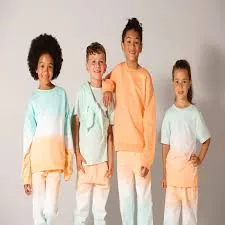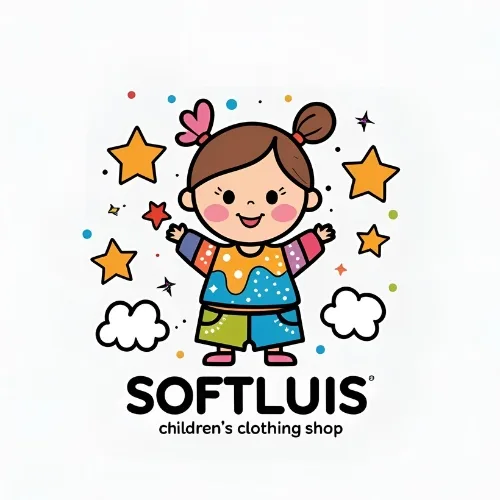News
The Rise of Gender-Neutral Kids’ Clothing: Embracing Comfort and Self-Expression Over Traditional Stereotypes
Introduction: The Shifting Fabric of Childhood
For centuries, children’s clothing has been rigidly defined by a simple binary: blue for boys, pink for girls. The aisles of clothing stores have long served as a visual manifestation of societal expectations, dictating not just color but also style, motif, and even perceived personality traits. Boys were given durability, adventurous themes, and muted colors; girls were adorned with pastels, ruffles, and gentle imagery.
However, the 21st century has ushered in a profound cultural re-evaluation, challenging long-held norms in every domain, including the seemingly innocuous world of children’s fashion. This movement is not just a trend; it is a significant sociological shift, reflecting a deeper understanding of identity, psychology, and the fundamental right of a child to uninhibited self-expression.
This comprehensive article explores the burgeoning phenomenon of gender-neutral kids’ clothing—often referred to as gender-fluid, gender-inclusive, or simply “kids’ clothing”—examining the forces driving its rise, the psychological and developmental benefits it offers, the challenges it faces, and the future it promises for the next generation. We will delve into how this category prioritizes comfort, functionality, and freedom of choice over outdated, restrictive gender stereotypes.
The Impetus for Change: Why Gendered Clothing is Being Challenged
The traditional model of gender-specific clothing is being dismantled by a confluence of social, psychological, and consumer-driven factors.
A. The Psychology of Gender Stereotypes
The most compelling argument against gendered clothing is its detrimental impact on child development. Clothing is one of the earliest forms of non-verbal communication and can inadvertently reinforce rigid stereotypes from infancy.
- Limiting Interest and Skill Development: By consistently associating boys with science, adventure, and strength (via dinosaur or truck motifs) and girls with domesticity, beauty, and gentleness (via princess or flower motifs), gendered clothing subtly limits a child’s perceived scope of interests and potential. A girl might internalize that engineering is “not for her,” and a boy might shy away from expressing a love for bright colors or dance, fearing ridicule.
- The Problem of the “Pink Tax”: Historically, clothing marketed toward girls often comes with an added cost—the “Pink Tax”—for features like ruffles, lace, or specific cuts, without necessarily offering better quality or functionality. Gender-neutral clothing promotes equal pricing and value.
- Encouraging Self-Censorship: By forcing children into pre-defined boxes, we risk encouraging self-censorship. A child might suppress innate preferences or interests—whether it’s a boy who loves glitter or a girl who prefers rough-and-tumble play in durable, non-frilly pants—to conform to what their clothes (and thus society) tell them they should be.
B. The Demand for Practicality and Comfort
Parents today are increasingly prioritizing clothing that supports a child’s fundamental need: to play.
- Functionality First: Gender-neutral designs often inherently favor practicality. They lean toward comfortable fabrics, loose-fitting silhouettes, durable construction, and pockets—a feature historically, and frustratingly, inconsistent in girls’ wear. When clothing is designed for movement and durability rather than aesthetic gender presentation, it simply functions better for active kids.
- Simplified Hand-Me-Downs and Sustainability: For the financially and environmentally conscious parent, gender-neutral clothing is a boon. It allows for seamless hand-me-down use between siblings and friends, regardless of their gender, extending the life cycle of the garment and aligning with the principles of sustainable fashion.
C. The Growing Cultural Conversation on Identity

The broader cultural dialogue around gender identity and sexual orientation has normalized the idea that gender is a spectrum, not a binary. Parents are seeking ways to raise children with an open mind, recognizing that identity is an internal experience, not an external performance dictated by clothing tags. This is about fostering an environment where children feel safe and validated regardless of how they choose to express themselves.
II. Defining Gender-Neutral Kids’ Fashion
Gender-neutral clothing is more than just removing pink and blue. It represents a design philosophy.
A. A Palette Beyond the Binary
The cornerstone of this movement is the color palette. Brands are moving away from restrictive binary colors to embrace a spectrum of rich, earthy, and vibrant tones:
- Earth Tones and Naturals: Sage green, mustard yellow, deep rust, terracotta, beige, and charcoal grey.
- Bold, Primary Colors: Classic reds, blues, and yellows, used without gender association.
- Universal Patterns: Stripes, geometric shapes, abstract prints, nature themes (animals, forests, space) that appeal broadly.
B. The Power of Silhouette and Cut
Gender-neutral clothing is characterized by silhouettes that accommodate a wide range of body shapes and active movements.
- Relaxed Fits: Think jogger pants, oversized sweatshirts, roomy tees, and simple, straight-cut dresses or tunics. These styles do not emphasize traditional masculine sharpness or feminine curves but instead prioritize ease of wear.
- Unisex Standardization: Clothes are often labeled simply by size (e.g., 5T, Size 6) without an accompanying “Boys” or “Girls” label, promoting a universal sizing standard.
- Pockets and Durability: A non-negotiable feature is the presence of functional pockets and the use of hard-wearing fabrics, typically associated with traditional “boys’ wear,” now applied universally.
C. The Emphasis on Ethical and Sustainable Production
Many brands pioneering the gender-neutral space are also leaders in ethical and sustainable production, utilizing materials like GOTS-certified organic cotton, hemp, and recycled fabrics. This alignment is not accidental; the desire to reject outdated consumer norms often extends to rejecting fast fashion’s environmental and labor practices.
The Developmental and Psychological Benefits
The true value of gender-neutral clothing lies in its contribution to a child’s psychological and social development.
A. Fostering Cognitive Flexibility and Creativity
When children are not subconsciously pigeonholed by their clothing, they develop greater cognitive flexibility. They are taught that attributes, colors, and interests are not inherently gendered. This freedom directly fuels creativity and imagination:
- A child can be a paleontologist and a fairy queen in the same comfortable, durable outfit.
- The focus shifts from “What should I wear as a boy/girl?” to “What do I want to be today?”
B. Supporting Self-Expression and Authenticity
Perhaps the most crucial benefit is the ability to support a child’s authentic self-expression.
- Choice and Agency: Giving a child the freedom to choose their clothes from a non-binary range empowers them with a sense of agency and control over their own bodies and presentation. This simple act builds self-esteem and teaches them to trust their own instincts and preferences.
- Reduced Body Shaming and Conformity Pressure: Gender-neutral styles tend to be less figure-hugging, reducing early exposure to body image concerns and the pressure to conform to narrow physical ideals often projected onto girls’ clothing.
C. Promoting Inclusivity and Empathy
In the social sphere, gender-neutral clothing subtly teaches children about inclusivity.
- Breaking Down Peer Barriers: When a child’s wardrobe is not marked by gender, it reduces the likelihood of peer judgment based on appearance, particularly for those who do not conform to gender stereotypes.
- Building Empathy: It normalizes the idea that people express themselves differently and that all expressions are equally valid, laying the groundwork for greater empathy and understanding of diverse identities later in life.
Challenges and Misconceptions in the Market
Despite its rapid growth, the gender-neutral movement is not without resistance and confusion.
A. Misconceptions: “Neutral” Does Not Mean “Bland”
A common criticism is the misconception that gender-neutral clothing equates to boring, drab, or colorless apparel.
- The Fear of Lost Individuality: Some parents worry that “neutral” means a loss of individuality or excitement. In reality, the most successful brands leverage bold colors and dynamic prints; they are simply prints that don’t rely on gender stereotypes (e.g., a shark print is for any child who likes sharks, not just boys).
- The “De-Gendering” Conflation: Critics sometimes incorrectly conflate gender-neutral fashion with rejecting gender entirely. The goal is not to deny a child’s gender identity but to ensure that their clothing choices are a reflection of their personality, not a mandate of their sex.
B. The Persistence of Traditional Retail Structures
Major retailers and department stores are slower to fully commit.
- The “Pink and Blue” Aisle: The physical organization of stores remains a significant hurdle. When parents shop, they often go to the clearly labeled “Girls” or “Boys” sections out of habit or convenience, making it difficult for truly “unisex” items to gain visibility.
- Marketing and Messaging: The advertising industry is still heavily reliant on gendered tropes. Breaking these decades-long marketing habits requires a fundamental restructuring of campaigns.
C. Pricing and Accessibility
While many pioneering brands are independent and ethically focused, this often translates to a higher price point, limiting accessibility for some families. To truly become the norm, gender-neutral lines must be adopted and scaled by major, more affordable fashion houses.
How Brands and Parents Can Drive the Movement Forward

The transformation requires concerted effort from both industry leaders and consumers.
A. Innovation in Design and Naming Conventions
Brands must continue to innovate beyond simple T-shirts and sweatpants:
- Diverse Silhouettes: Introducing sophisticated designs that are tailored for comfort and style but remain gender-agnostic (e.g., jumpsuits, wide-leg trousers, simple yet elegant outerwear).
- Abolishing Gender Labels: Refusing to use “Boy” or “Girl” in product names and descriptions, opting for functional descriptors like “The Adventure Pant” or “The Cozy Jumper.”
- Inclusive Marketing: Using diverse child models in advertising who are happily engaging in a wide range of activities, without their clothing dictating the “correct” role.
B. Empowering Parental Choice
Parents have the ultimate power to reshape the market through their purchasing decisions:
- Prioritizing Function Over Form: Choosing clothes based on durability, pockets, comfort, and the child’s own preference, rather than on the traditional aesthetic.
- Shopping Across the Aisles: Actively seeking out items in both traditional “boys” and “girls” sections, or specifically shopping from dedicated gender-neutral brands.
- Open Dialogue with Children: Asking open-ended questions like, “Which outfit makes you feel best?” or “What color do you like today?” This simple act reinforces the value of their choice.
The Future: A World of Universal Kids’ Wear
The trend toward gender-neutral clothing is not a fleeting one; it is a permanent fixture in the evolving social landscape.
A. The End of Separate Departments
In the near future, the distinction between “Boys” and “Girls” clothing departments may become obsolete. Retail spaces will likely evolve into Universal Kids’ Sections organized by style (e.g., Active Wear, Formal Wear, Sleep Wear) or size, making the gender of the recipient irrelevant.
B. Clothes as Tools for Identity Exploration
For the next generation, clothing will be seen less as a uniform of conformity and more as a tool for identity exploration. This shift aligns with broader educational goals: to raise resilient, empathetic, and mentally flexible individuals who value authenticity above all else.
Conclusion: Dressing for the Whole Child
The rise of gender-neutral kids’ clothing is a powerful testament to our changing societal values. It is a movement rooted in the desire to liberate children from the subtle, yet powerful, constraints of outdated traditions. By embracing designs that prioritize comfort, durability, and a spectrum of color, we are not just changing the way children dress; we are changing the way they are perceived and, crucially, the way they perceive themselves.
The core message of this movement is simple and profound: Dress the child, not the gender. When we allow children the freedom to choose, we affirm their right to define their own world, their own interests, and their own path, laying the foundation for a more inclusive, creative, and authentic future for all.
Challenges and Misconceptions in the Market
Despite its rapid growth, the gender-neutral movement is not without resistance and confusion. Understanding these hurdles is crucial for advocates and brands aiming to normalize this approach.
A. Misconceptions: “Neutral” Does Not Mean “Bland”
A common criticism is the misconception that gender-neutral clothing equates to boring, drab, or colorless apparel. This is a significant barrier to adoption for parents who associate vibrant colors and specific motifs with the joy of childhood.
- The Fear of Lost Individuality: Some parents worry that “neutral” means a loss of individuality or excitement. In reality, the most successful brands leverage bold colors and dynamic prints; they are simply prints that don’t rely on gender stereotypes (e.g., a shark print is for any child who likes sharks, not just boys). Gender-neutrality actually broadens the scope of expression, moving beyond a restricted palette to include all colors and all themes.
- The “De-Gendering” Conflation: Critics sometimes incorrectly conflate gender-neutral fashion with rejecting gender entirely. The goal is not to deny a child’s gender identity but to ensure that their clothing choices are a reflection of their personality and comfort, not a mandate of their biological sex. It’s about freedom of expression, not freedom from gender.
- The Marketing Language Gap: The industry still struggles with how to market these items effectively. Using terms like “unisex” can sometimes conjure images of simple, shapeless gray garments, while the reality in boutique brands is often highly stylish, colorful, and thoughtfully designed apparel.
B. The Persistence of Traditional Retail Structures
Major retailers and department stores are slower to fully commit, often due to entrenched logistical systems and consumer buying habits.
- The “Pink and Blue” Aisle: The physical organization of stores remains a significant hurdle. When parents shop, they often go to the clearly labeled “Girls” or “Boys” sections out of habit or convenience, making it difficult for truly “unisex” items to gain visibility. Consumers are trained to shop within these binary boundaries. For a gender-neutral line to succeed in a large store, it requires its own distinct, well-signed section to disrupt the traditional flow.
- Inventory Management Challenges: Traditional inventory systems are built on gender segmentation. Transitioning to a non-binary stock system is a large, costly undertaking for established global brands, requiring changes in sourcing, warehousing, and digital tagging.
- The “Safe” Design Trap: Many large companies dip their toes into gender-neutral lines by producing overly generic, safe items (like simple gray sweatshirts) to minimize risk, failing to capture the vibrancy and design innovation that defines the leading independent brands.
C. Pricing and Accessibility
While many pioneering gender-neutral brands are independent and ethically focused, this dedication often translates to a higher price point, limiting accessibility for some families.
- Cost of Ethical Sourcing: Using GOTS-certified organic cotton, ensuring fair wages, and implementing sustainable dyeing processes inevitably raises the production cost per garment. While consumers value sustainability, budget constraints often win out in high-frequency purchasing categories like children’s wear.
- The Need for Scale: To truly become the norm, gender-neutral lines must be adopted and scaled by major, more affordable fashion houses (like Target, H&M, or Zara Kids). This would drive the cost down and make the choice accessible to families across all income brackets. The goal is to make functional, non-stereotypical clothing the baseline expectation, not a luxury niche.
The Role of Education and Societal Influence

The movement in fashion is inextricably linked to broader conversations about parenting, education, and media representation.
A. The Impact of Media and Marketing Representation
Marketing is the most powerful tool for shaping consumer perception, and it needs a fundamental overhaul.
- Diversifying Models and Scenarios: The most effective gender-neutral marketing showcases children (regardless of their gender presentation) happily engaging in a wide range of activities. This means showing boys nurturing dolls and girls playing with construction kits—without making a fuss about the clothing itself. The focus is on the activity and joy, not the gender of the child wearing the outfit.
- Challenging the Pink/Blue Coding in Media: The conversation extends beyond clothing to toys, television shows, and advertising. When children’s media moves away from rigid gender coding, the clothing follows naturally.
- The Importance of Adult Role Models: Parents, educators, and public figures who openly embrace non-traditional aesthetics for their own children serve as powerful visual catalysts, normalizing the movement and providing aspirational examples.
B. The Classroom as a Catalyst
Schools and early childhood educators play a vital role in reinforcing or challenging gender norms.
- Dress Codes and Policy: Advocating for school dress codes that focus purely on safety and decency, rather than those that indirectly enforce gender norms (e.g., specific requirements for skirt/trouser length based on sex), is essential.
- Toy and Book Selection: A gender-neutral clothing movement is amplified by providing children with a gender-inclusive environment—classrooms stocked with diverse books featuring non-gender-conforming characters and play areas where all children are encouraged to engage with all types of toys (trucks, kitchens, building blocks, costumes).
- Teacher Training: Ensuring teachers are trained to use gender-neutral language (e.g., referring to a group as “children” or “everyone” instead of “boys and girls”) helps create a seamless transition from home to school where self-expression is valued.
C. Parental Mindset: A Shift from Prescription to Observation
The final and most important driver is the parent’s mindset. It requires moving from a mindset of prescribing what a child should like to one of observing and affirming what a child naturally gravitates toward.
- Letting the Child Lead: Parents must learn to view their child’s choice of clothing as a reflection of their inner world and personality, not a reflection of the parent’s success at raising a “typical” boy or girl.
- Addressing Family and Peer Pressure: Empowering children often means equipping them (and yourself) with the language to handle pushback from extended family or peers who hold traditional views. This involves gently but firmly stating, “This is what they chose, and they are happy.”
The Future: A World of Universal Kids’ Wear
The trend toward gender-neutral clothing is not a fleeting one; it is a permanent fixture in the evolving social landscape, moving steadily from niche to norm.
A. The End of Separate Departments
In the near future, the distinction between “Boys” and “Girls” clothing departments may become obsolete. Retail spaces will likely evolve into Universal Kids’ Sections organized by style (Active Wear, Outerwear, Sleep Wear) or size, making the gender of the recipient irrelevant. This shift will make shopping more efficient and less psychologically loaded for parents and children.
B. Clothes as Tools for Identity Exploration
For the next generation, clothing will be seen less as a uniform of conformity and more as a tool for identity exploration. This shift aligns with broader educational goals: to raise resilient, empathetic, and mentally flexible individuals who value authenticity above all else. This freedom will extend to the development of fashion-forward lines that focus on innovative fabric technology, comfort, and sustainable design, rather than just color and motif.
C. Industry Integration
We are already seeing large legacy brands cautiously integrate gender-neutral pieces into their general collections, rather than isolating them into separate capsules. This is the surest sign of mainstream acceptance. Eventually, the term “gender-neutral” will fade, as all children’s clothing will simply be designed for children.
Conclusion: Dressing for the Whole Child
The rise of gender-neutral kids’ clothing is a powerful testament to our changing societal values. It is a movement rooted in the desire to liberate children from the subtle, yet powerful, constraints of outdated traditions. By embracing designs that prioritize comfort, durability, and a spectrum of color, we are not just changing the way children dress; we are changing the way they are perceived and, crucially, the way they perceive themselves.
This movement is an act of psychological liberation for the child and a quiet revolution for the fashion industry. The core message of this movement is simple and profound: Dress the child, not the gender. When we allow children the freedom to choose, we affirm their right to define their own world, their own interests, and their own path, laying the foundation for a more inclusive, creative, and authentic future for all.

